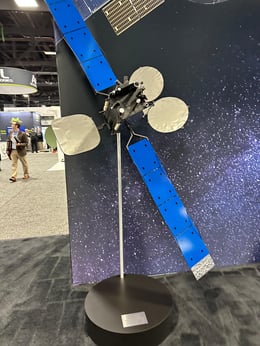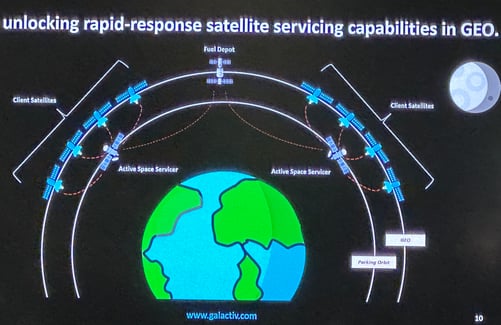The conference SATELLITE 2024 happens next week, March 18-21, in Washington, DC. It's a fascinating mixture of people showing off their tiny microwave waveguides, military officers in uniforms, and Amazon executives touting their K-band radio signals and startups proposing satellite refueling services.
Historically, consumers have experienced satellite communication as one-way television. Later, high-latency, low-speed Internet became available. In the US, companies like HughesNet sold Internet access to custo mers using geosynchronous-orbit ("geo") satellites. The original generation of Geo satellites experienced a high delay in transmission because of the speed of light.
mers using geosynchronous-orbit ("geo") satellites. The original generation of Geo satellites experienced a high delay in transmission because of the speed of light.
Humans rarely get annoyed because light travels so slowly! The long spaceflight of the signal to GEO satellites results in latency of over 300 ms. This number measures the latency from groundA to space to groundZ, and then the response is groundZ to space to groundA. This high latency makes video or voice communication via satellite difficult and much different from the low-latency experience we're accustomed to with telephones.
This delay between two participants in a call is always a significant concern for collaboration technology. A 2022 article published in the MIT Journal PRESENCE predicts that 100 ms is the threshold for normal human communication. This human limit of around 100 ms sets an upper bound for effective and comfortable human communication - be it desktop sharing, voice or video.
Satellite technology is an exciting new broadband option with Low-Earth Orbit (LEO) satellites. Whereas GEO satellites are 22,236 miles from the Earth, LEO satellites are 1,200 miles from the Earth. That's 95% closer to Earth, so the latency is much lower. According to John Burke of Nemertes Research, this results in total round-trip latency of 30 ms to 50 ms. Many Americans are familiar with StarLink, the LEO satellite Internet service provided by Elon Musk. It's available for much of the world's population and provides Internet service with latency suitable for collaboration & UC. This means Video calls and work can be conducted from obscure and remote locations. It also means UC customers - enterprises and small businesses - are adopting LEO Internet access as their primary tool.
 But StarLink, even for its headstart, isn't alone. Technology correspondent Kristin Cooke counts seven LEO constellations under construction—and that's only the firms with US participants. Operators outside the US have ongoing projects, like China's Guowang and G60 Starlink.
But StarLink, even for its headstart, isn't alone. Technology correspondent Kristin Cooke counts seven LEO constellations under construction—and that's only the firms with US participants. Operators outside the US have ongoing projects, like China's Guowang and G60 Starlink.
Today, an enterprise needs a fiber-optic link to provide sufficient voice, video, and collaboration performance. While rudimentary email and web access were available to most of the world's population, the best Internet was primarily for those in wealthy countries and near major population centers. The latest data from the International Telecommunications Union, a United Nations Organization, shows that Americans' broadband connectivity is well over double the global average. There's a lot of ground to cover.
Competitive LEO Satellite Internet has the potential to bypass boundaries set by authoritarian governments. Imagine if you had the skills and energy to work and produce, but you couldn't join a Teams meeting, either because of lack of access or because your government was blocking access. Then, Imagine if LEO access became available, and you could begin to access the Internet with a competitive choice of Internet providers: Massive new productivity options would await you. I expect this kind of change to come about. LEO-based Internet could unlock substantial economic growth for nations around the world.
economic growth for nations around the world.
It's high time the collaboration service providers understood what makes satellite networking work to anticipate the spaceport connections, new customer routers, and new network conditions experienced by LEO satellite Internet customers. Collaboration technologies will be available to new people and places, but today, the Cloud Communications and Satellite industries need to be more closely linked to take more advantage of the opportunity.


